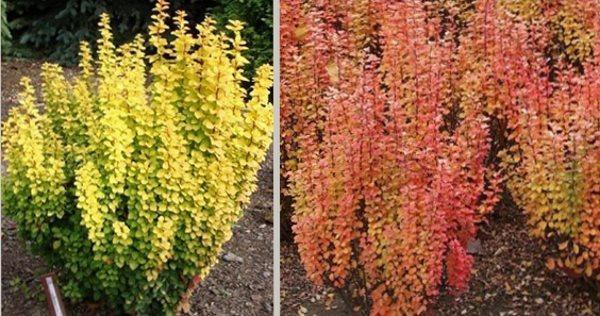Bright and inaccessible shrub barberry Thunberg Maria
 Recently, it has become fashionable to use various types of ornamental shrubs to decorate plots. One of these plants is barberry Thunberg, namely, its variegated species. Due to the variety of colors of the leaves, you can create whole compositions by combining varieties not only with different colors of the leaf plate, but also alternating low-growing species with tall ones. Among the latter, it is worth highlighting the barberry Maria, which is widely used to create a hedge.
Recently, it has become fashionable to use various types of ornamental shrubs to decorate plots. One of these plants is barberry Thunberg, namely, its variegated species. Due to the variety of colors of the leaves, you can create whole compositions by combining varieties not only with different colors of the leaf plate, but also alternating low-growing species with tall ones. Among the latter, it is worth highlighting the barberry Maria, which is widely used to create a hedge.
What does barberry Maria look like?
An adult bush of variegated Mary is capable of reaching a height of 1.5 m and a width of up to 1 m. Barberry grows in the form of a wide column, while long strong shoots are directed strictly vertically and form a very dense crown.
Maria is ideal for forming a fence - it is almost impossible to get through a dense high wall, especially when you consider the presence of long and sharp thorns on the branches.
The branches of a young bush are pink with a slight orange tint, with age the shoots darken. The deciduous plate is rounded, slightly elongated at the end.
A feature of the variety is the ability to change the color of the leaves:
- in the spring-summer period they have a beautiful yellow color, similar to gold, with a pink border around the edges;
- with the onset of autumn, the yellow color of the foliage turns to orange, and the pink border turns red.
In May, yellow flowers of a bizarre shape, similar to small balls, bloom on the barberry of Thunberg Maria. The upper petals are pale pink, and the inflorescences are tied in 2-3 pieces. In October, the first harvest of rather large, glossy red berries can already be harvested. Fruits can stay on the branches for a long time without falling to the ground.
Features of planting and care
Barberry can be planted both in spring and autumn. It is preferable to take the place on the sunny side of the site, away from groundwater. The shrub is able to grow on almost any soil, but it develops best on fertile soil, therefore it is recommended to add organic matter to poor soil.
When planting barberry Maria in partial shade, the leaves may lose their bright color.
The dense, strong root system of the bush tolerates transplanting well and ensures good survival of the barberry during reproduction. If you wish, you can give the shrub a certain shape, since it also reacts perfectly to a haircut.
The variety is highly resistant to adverse weather conditions.